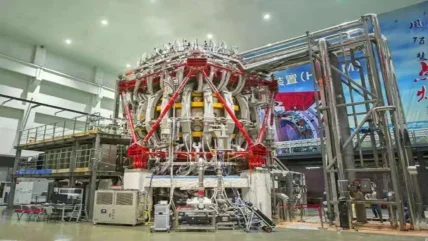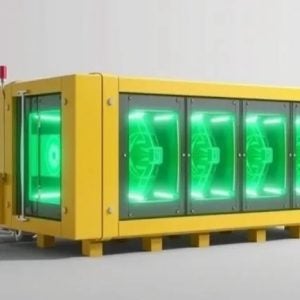
 China’s "artificial sun", the HL-2M tokamak, has set a new operation record with its plasma current exceeding 1 million amperes (one megampere) “marking a major step toward fusion ignition”, China National Nuclear Corporation (CNNC) has announced. The tokamak, independently designed and built by CNNC’s Southwestern Institute of Physics (SWIP) in Chengdu, Sichuan Province, was completed in November 2019 and achieved its first plasma discharge in December 2020.
China’s "artificial sun", the HL-2M tokamak, has set a new operation record with its plasma current exceeding 1 million amperes (one megampere) “marking a major step toward fusion ignition”, China National Nuclear Corporation (CNNC) has announced. The tokamak, independently designed and built by CNNC’s Southwestern Institute of Physics (SWIP) in Chengdu, Sichuan Province, was completed in November 2019 and achieved its first plasma discharge in December 2020.
The plasma current intensity is a key parameter of a tokamak and the HL-2M tokamak now boasts a plasma current intensity of over 2.5 megamperes and has run smoothly under conditions of more than 1 megampere by volume, CNNC said. "The breakthrough marks an important step towards fusion ignition in nuclear fusion research and development in China," said Zhong Wu, deputy director of the Centre for Fusion Science at SWIP and head of the HL-2M experiment, at an interview with Science and Technology Daily. The tokamak achieved a continuous high-temperature plasma operation for 1,056 seconds in December 2021, the longest duration of its kind in the world at that time.
SWIP, as a core institute in the R&D of controlled nuclear fusion, is important support institute for China’s participation in the International Thermonuclear Experimental Reactor (ITER), has developed various types of magnetic confinement fusion devices.
The HL-1, the first Tokamak device independently built by China in 1984, was an important milestone in China’s nuclear fusion reaction research and provided the experience for China to independently design, build and operate nuclear fusion devices, Wu noted.
HL-2M is an upgrade of China’s previous model, the HL-2A – one of three major domestic tokamaks now in operation in China. The other two are the Experimental Advanced Superconducting Tokamak (EAST) machine at the Institutes of Physical Science, Chinese Academy of Sciences (ASIPP) in Hefei and J-TEXT at the Huazhong University of Science and Technology (HUST).
China started nuclear fusion research in the 1960s and included construction of the HL-1 (upgrade HL-1M) in SWIP and other small tokamaks such as the KT-5 in the University of Sciences and Technology of China (USTC) and the upgraded CT-6B at the Institute of Physics of the Chinese Academy of Sciences (IP CAS) in Beijing as well as the first domestic superconducting tokamak, the medium sized tokamak HT-7 at ASIPP.
Image: China claims to have made an exciting breakthrough in the race to create an artificial sun (courtesy of the Southwestern Institute of Physics)






